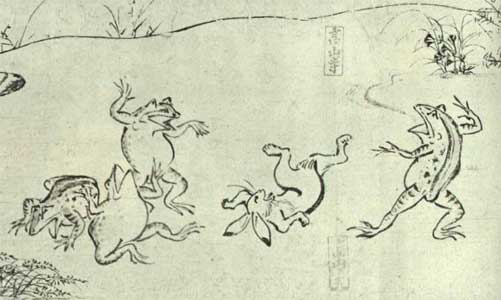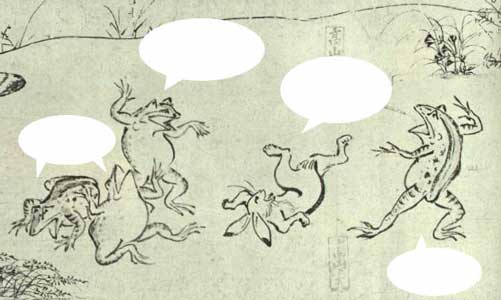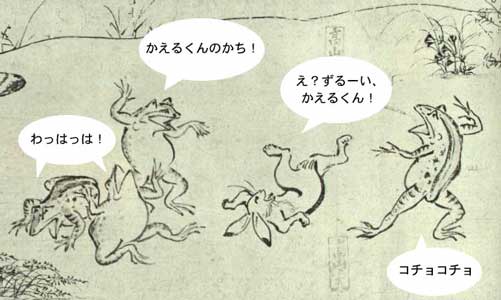Teacher Instructions
- Before class prepare the handout and the transparencies.
- Show Transparency 1 and ask what the comic strips have in common. (Answer: Animals act like human beings.)
- Show a part of the picture scroll called "Choojuu-jinbutsu-giza," or "Choojuu-giga" for short on Transparency 2. Ask the students questions by referring to Teacher Presentation Sample Scripts below. Ask if it is an old picture or not, what is in the picture, and what the characters are doing. Ask them questions so that they realize the animals in the picture are the representation of human beings.
- Distribute the handout and have the students read the questions for Activity 1.
- Have the students listen to the dialogue and answer the comprehension questions. Review their answers.
- Have the students do Activity 2 in pairs. Ask the students share their ideas.
- Have the students read the instruction for Activity 3. Show the example on Transparency 3.
- Have some students present their dialogues.
- Have the students do Activity 4 in pairs. Discuss it in the class.
Teacher Presentation Sample Scripts
この絵は古い絵だと思いますか。絵の中に何がいますか。何をしていると思いますか。(Animals are playing sumo.) ここにいる動物は少し変だと思いませんか。(The intention of this question is to have the students aware that the animals in the picture are a representation of human beings.) (Give them more hints: カエルはうさぎとすもうをしますか。カエルは足で立ちますか。)
Scripts for Listening Activities
| 先生: |
アンディーさん、京都旅行はどうでしたか。 |
| 学生: |
とても、楽しかったです。これ、おみやげです。高山寺(こうざんじ)で 買いました。 |
| 先生: |
ありがとう。有名な鳥獣人物戯画(ちょうじゅうじんぶつぎが)の絵はがきですね。
|
| 学生: |
はい。十二世紀に描かれた絵だと聞きました。 |
| 先生: |
そうですね。アンディーさんは漫画とかアニメが好きですよね。 |
| 学生: |
はい、とっても。 |
| 先生: |
この絵は日本の漫画やアニメの原点だって言われているんですよ。 |
| 学生: |
原点? |
| 先生: |
ええ、原点というのは「はじめ」という意味。初めて描かれた漫画っていうことですよ。 |
| 学生: |
え!そうなんですか・・・わあ、知らなかった。 |
| 先生: |
動物が子供のように生き生きと描かれていますね。 |
| 学生: |
そうですね。 |
Answer Key to Student Activities
1.
1) 京都のおみやげとして、この絵はがきを先生にあげている。
2) 12世紀
3) この絵は漫画やアニメの原点だと言われているから。
2. (Although both are said to be laughing, answer may vary depending on each students' perception. In this sense, there is no correct answer.)
3. See Transparency 3.
4. Many comic artists use animals to personify human beings and to criticize or ridicule society and politics.
Note: "Choojuu giga" is believed to be a criticism for the aristocracy and the Buddhism circle. You can rarely find illustrations that personify humans as lively as this picture scroll at this early stage in the world history.
Resources
ウィキペディア フリー百科事典 (http://ja.wikipedia.org/wiki 鳥獣人物戯画)
The picture used in this activity is a part from a picture scroll. This website provides you a link that lets you "scroll" the entire picture scroll. Find the link called 鳥獣戯画・甲巻全画像 at the bottom of the page.
鳥獣戯画
http://www.mmjp.or.jp/gigas/GIGATALK.htm#10
世界遺産巡り
http://hukumusume.com/366/world/isan/itiran_kokuhou/027.htm


